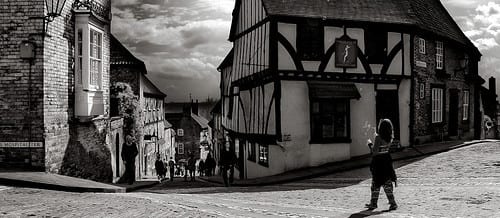Using the advice from Rachel after our first run-through, we decided to re-write the audio script to have a conversational tone. Whilst we had previously written what we planned to say on paper and read it out for recording, this time we did not want it to sound too scripted. Thus, we recorded our entire conversation of our meeting as we went through every part of the audio saying ideas for what should be said. This naturally allowed for the words to sound friendly and relaxed, and helped us to experience what our audience would hear from our idea suggestions. After recording our conversation, we each went away and wrote up sections of the audio we now had. An example of the transcript I made is here:
“Why don’t we move on from this space to the next part of our journey, and press play on audio 2. (Audio 2) Lets turn around to face the picnic blanket where we started off our journey. If you look to your left there’s a black railing, why don’t we follow it around the corner of the Cathedral and see where it takes us? Keep an eye out for portals to Narnia and little pixie huts. Have you found what you were looking for? I’ve come this way before, if I remember right there’s a statue on the left of a man with his dog. Why don’t we go and find it? Why don’t you have a break from me for a while, and press pause whilst you make your way over to the statue.”
Once we have the entirety of the new audio script, we plan to record it again and do another run-through with the new audio, the planned moments and “guinea-pig” audience members.
In thinking of how to make our audio conversational, we all thought of the “Every day moments” podcasts that we had listened to in class. The podcasts were created by individual artists as audio pieces to listen to in particular moments and settings in the day. I went away and listened to two of them, one by Adrian Howels and one by Lemm Sissay, for inspiration. The first podcast, found here by Adrian Howels, is “designed to be listened to in the early hours of the morning, in bed with a hot drink”. (Howell, 2011) One aspect I found similar to what we wanted to use in our audio was the use of background noise, whether it be the noise of static, the television, a slurp of drink or a yawn. We also want to use sounds in our audio, such as the sound of birds or wedding bells, and hearing our idea used likewise has shown how effective they can be in enhancing an emotion or thought for the audience. The second podcast, Late Night Rain, found here by Lemm Sissay, is “designed to be listened to exactly then – late at night”. (Sissay, 2011) The tone of the voice in this audio is how I think we should aim to sound in our piece: talkative and fouced on the listener. The language used was simple and yet effective in portraying what they wanted to to the listener, which is what we also want to do. Listening to these podcasts was an effective way of understanding and hearing how our audience can experience our audio, by making myself an audience member to a different audio piece.
Howels, A. (2011) Everyday Moments 11: audio drama for private performance. The Guardian. [online] Available from http://www.theguardian.com/culture/audio/2011/nov/21/everyday-moments-podcast-adrian-howells [Accessed 24 April 2015].
Sissay, L. (2011) Everyday Moments 10: audio drama for private performance. The Guardian. [online] Available from http://www.theguardian.com/culture/audio/2011/oct/21/everyday-moments-podcast-lemn-sissay [Accessed 24 April 2015].
